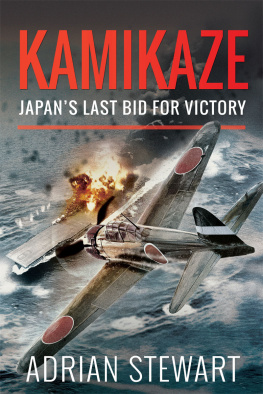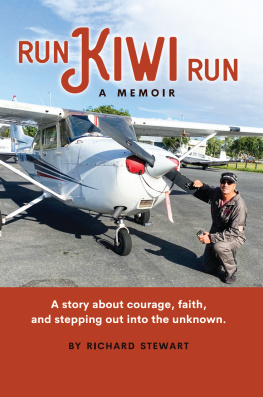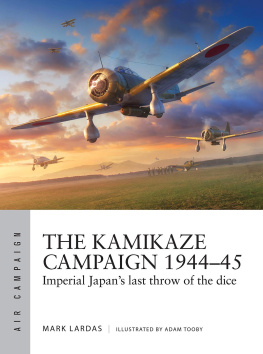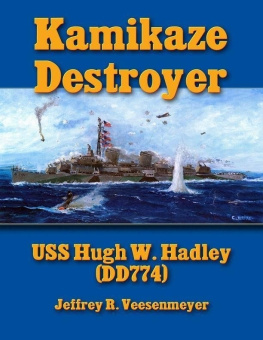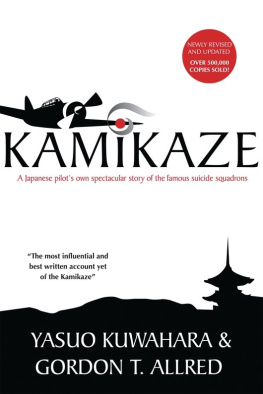Stewart - Kamikaze
Here you can read online Stewart - Kamikaze full text of the book (entire story) in english for free. Download pdf and epub, get meaning, cover and reviews about this ebook. year: 2020, publisher: Pen and Sword Aviation, genre: History. Description of the work, (preface) as well as reviews are available. Best literature library LitArk.com created for fans of good reading and offers a wide selection of genres:
Romance novel
Science fiction
Adventure
Detective
Science
History
Home and family
Prose
Art
Politics
Computer
Non-fiction
Religion
Business
Children
Humor
Choose a favorite category and find really read worthwhile books. Enjoy immersion in the world of imagination, feel the emotions of the characters or learn something new for yourself, make an fascinating discovery.
Kamikaze: summary, description and annotation
We offer to read an annotation, description, summary or preface (depends on what the author of the book "Kamikaze" wrote himself). If you haven't found the necessary information about the book — write in the comments, we will try to find it.
Kamikaze — read online for free the complete book (whole text) full work
Below is the text of the book, divided by pages. System saving the place of the last page read, allows you to conveniently read the book "Kamikaze" online for free, without having to search again every time where you left off. Put a bookmark, and you can go to the page where you finished reading at any time.
Font size:
Interval:
Bookmark:

Kamikaze
Japans Last Bid for Victory
Adrian Stewart

First published in Great Britain in 2020 by
Pen & Sword Aviation
An imprint of
Pen & Sword Books Ltd
Yorkshire Philadelphia
Copyright Adrian Stewart 2020
ISBN 978 1 52674 803 4
eISBN 978 1 52674 804 1
Mobi ISBN 978 1 52674 805 8
The right of Adrian Stewart to be identified as Author of this work has been asserted by him in accordance with the Copyright, Designs and Patents Act 1988.
A CIP catalogue record for this book is
available from the British Library.
All rights reserved. No part of this book may be reproduced or transmitted in any form or by any means, electronic or mechanical including photocopying, recording or by any information storage and retrieval system, without permission from the Publisher in writing.

Pen & Sword Books Limited incorporates the imprints of Atlas, Archaeology, Aviation, Discovery, Family History, Fiction, History, Maritime, Military, Military Classics, Politics, Select, Transport, True Crime, Air World, Frontline Publishing, Leo Cooper, Remember When, Seaforth Publishing, The Praetorian Press, Wharncliffe Local History, Wharncliffe Transport, Wharncliffe True Crime and White Owl.
For a complete list of Pen & Sword titles please contact
PEN & SWORD BOOKS LIMITED
47 Church Street, Barnsley, South Yorkshire, S70 2AS, England
E-mail:
Website: www.pen-and-sword.co.uk
Or
PEN AND SWORD BOOKS
1950 Lawrence Rd, Havertown, PA 19083, USA
E-mail:
Website: www.penandswordbooks.com
This book is dedicated to all those who helped.
There were so many, but I must mention in particular:
Jim Ozawa, who when we regularly refought the Pacific War together, many years ago now, first introduced and explained to me the actions and motives of the Kamikaze organizers and pilots.
David Mattiske, Maya Sieber and Simon Thayer, who between them recently revived my interest in this subject.
My agents Johnson & Alcock Limited, especially my helpful and encouraging liaison officer Ed Wilson.
My knowledgeable and industrious editor Pamela Covey.
The Birmingham & Midland Institute & Library, the Taylor Library and the US Navy Department of Information who assisted with the photographs.
Brigadier Henry Wilson and the staff of my publishers Pen & Sword Books Limited, especially Jon Wilkinson who sorted out the jacket, Dominic Allen who sorted out the plates, SJ who sorted out the maps and the ever-patient Matt Jones and Laura Hirst who sorted out everything else.
Im very lucky and Im very grateful.
L ieutenant Mimori Suzuki was considered by his comrades to be rather unusual for an officer of the Imperial Japanese Naval Air Force. Not only was he regarded as an artistic type, but although Suzuki is one of the most common Japanese surnames, his looks seemed more European than Oriental and were often the subject of unkind banter. He was a good pilot, though, and when on 7 December 1941, he took off from aircraft carrier Akagi to participate in the assault on the United States Pacific Fleet in Pearl Harbor, he was doubtless ready to do his duty to the best of his ability.
Suzuki was at the controls of an Aichi D3A dive-bomber or, as it was known to the Allies, a Val, since in order to avoid the difficulties caused by Japans complicated system of aircraft classification, it was customary to give each one an arbitrary code-name, the bombers having those of ladies, the fighters those of men. Suzuki and the rest of his squadron would direct their attack on vessels to the north-west of Ford Island, the side opposite to the one boasting the famous Battleship Row. His personal target would be the seaplane tender Curtiss .
Although Curtiss was a naval auxiliary rather than a warship, she and her crew were full of fight and had already been in action before the Vals appeared. The Japanese had sent five midget submarines to join in the attack on Pearl Harbor; most unwisely since they not only did no damage but were sighted early and so could and perhaps should have given the Americans warning of what was to follow. One of them did, however, penetrate the harbour and at about 0835, was sighted by Curtiss . It launched a torpedo that missed; Curtiss retaliated by putting a shell through its conning tower. Then destroyer Monaghan that, unlike Curtiss , was already under way, charged in, dodged another torpedo, rammed the midget and finally destroyed it with depth-charges while the area resounded with cheering.
So the ships to the north-west of Ford Island were very ready for a fight when the dive-bombers appeared. They shot down at least five of these between them, Curtiss certainly claiming one. This was the aircraft piloted by Lieutenant Mimori Suzuki: it did not pull out of its dive but, at about 0910, it crashed into the starboard crane used by Curtiss to raise and lower her seaplanes. Fires were started, but although later struck by a bomb and near-missed by several others, Curtiss survived without serious damage. It seems likely that Suzuki had been killed or disabled before the Val struck Curtiss but it is possible that he flew it into her deliberately.
There is no doubt at all about another action taken this same day by Lieutenant Fusata Iida from aircraft carrier Soryu . A quiet, capable and very determined officer, Iida was a great believer in physical fitness and an ardent admirer of baseball, a sport that the Japanese had acquired from their future enemies, though they had found their own names for players and officials such as pitchers and umpires. He flew a Mitsubishi A6M fighter that the Allies, in accordance with the principle mentioned earlier, officially code-named the Zeke. In practice it was rarely so-called. Another Japanese designation for this aircraft was the Navy Type 00 or Zero-Sen. Japans enemies followed this example and the A6M was almost invariably called the Zero or, by RAF pilots, the Navy Nought.
During the Pearl Harbor raid, the Zeros concentrated on making strafing runs on vehicles, groups of men and especially aerodromes where the American aircraft, lined up together in the centre of the field as a precaution against sabotage, made ideal targets. In all 188 of these were destroyed, with 159 more damaged. The Zeros, it was reported, swooped unbelievably low in their attacks. In the process they came under fire from machine guns, rifles and even pistols, but whereas fifteen Vals and five Nakajima Kate torpedo-bombers were lost, only nine Zero pilots did not return to their carriers.
One who did not was Lieutenant Fusata Iida. His fighter was fatally damaged during a strafing attack but was seen to climb away, still under control. Then it turned back and dived, clearly quite intentionally, straight at and into an aircraft hangar, effectively demolishing it and the machines it contained. The very first day of the Pacific War had seen one, possibly two, Japanese airmen make what would later be called a suicide dive.
It has been suggested that they had also been the first Kamikaze pilots. In fact, their actions, though repeated on several occasions during the next two years and ten months, were fundamentally different from the Kamikaze missions as we shall see. Nonetheless they are worth recording because the motives behind them help to explain the Kamikaze creed and themselves arose from beliefs embedded in the Japanese character by events in their countrys history.
Font size:
Interval:
Bookmark:
Similar books «Kamikaze»
Look at similar books to Kamikaze. We have selected literature similar in name and meaning in the hope of providing readers with more options to find new, interesting, not yet read works.
Discussion, reviews of the book Kamikaze and just readers' own opinions. Leave your comments, write what you think about the work, its meaning or the main characters. Specify what exactly you liked and what you didn't like, and why you think so.

